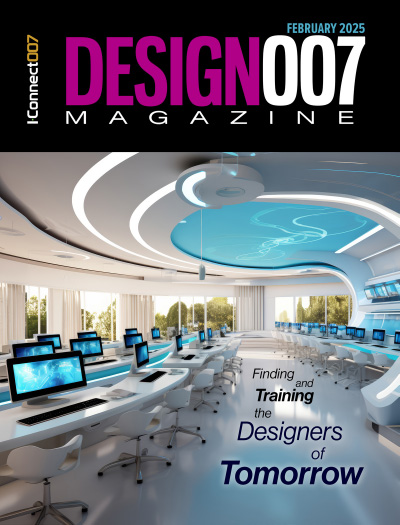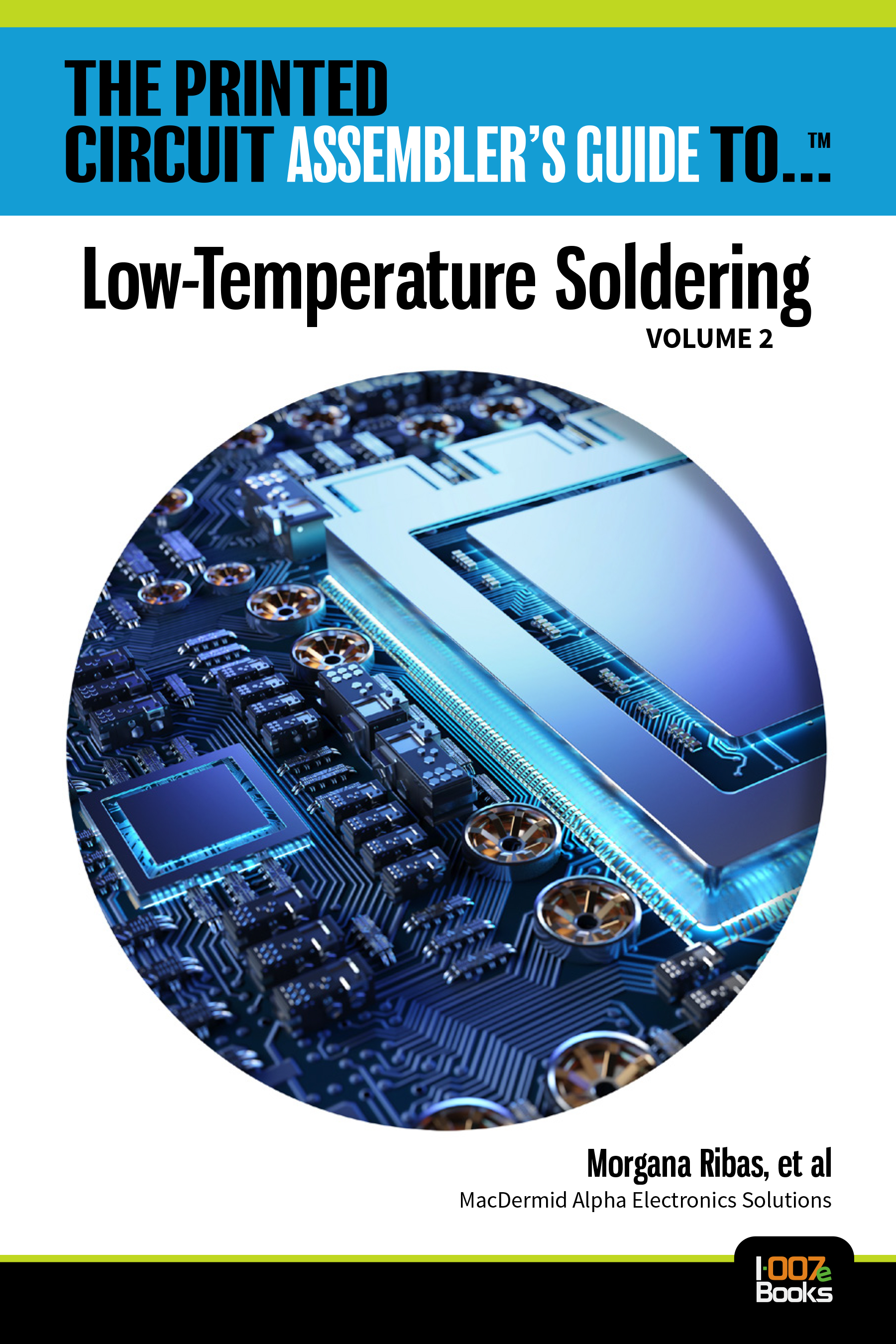-

- News
- Books
Featured Books
- design007 Magazine
Latest Issues
Current Issue
Training New Designers
Where will we find the next generation of PCB designers and design engineers? Once we locate them, how will we train and educate them? What will PCB designers of the future need to master to deal with tomorrow’s technology?

The Designer of the Future
Our expert contributors peer into their crystal balls and offer their thoughts on the designers and design engineers of tomorrow, and what their jobs will look like.

Advanced Packaging and Stackup Design
This month, our expert contributors discuss the impact of advanced packaging on stackup design—from SI and DFM challenges through the variety of material tradeoffs that designers must contend with in HDI and UHDI.
- Articles
- Columns
Search Console
- Links
- Media kit
||| MENU - design007 Magazine
Mentor’s Cristian Filip Discusses His Award-winning DesignCon Paper
March 21, 2019 | Andy Shaughnessy, Design007 MagazineEstimated reading time: 4 minutes
During DesignCon, I met with Cristian Filip, a senior product architect with Mentor, a Siemens business. Cristian had just received word that his paper had won a DesignCon Best Paper award—his second such award in three years. I asked Cristian to discuss his paper and how this technology can help improve manufacturing yields at high volumes.
Andy Shaughnessy: Congratulations, Cristian. You’ve written a paper that just won a DesignCon Best Paper Award. Can you tell us about yourself and the paper?
Cristian Filip: Sure. I joined Mentor in 2014. I work in the product architecture group and am involved mostly with analysis solutions. Over the last few years, I’ve co-authored about six DesignCon papers—two of them winning the Best Paper Award. One paper won in 2016 jointly with Vladimir Zdorov—one of our developers. In 2018, it was a collaboration between Hamburg University, Cisco, and Mentor.
Both of those papers that won the Best Paper Award centered around high-speed serial links, running at 28 gigabits per second. And they used channel operating margins as a figure of merit for estimating channels performance. In 2017, I had another DesignCon paper on the same area of interest, and we showed how to optimize channels while accounting for manufacturing reliability. At that time, we used design of experiments (DOE) as a method for optimization along with artificial neural networks. As a next step in the paper from 2018, we explored some improvements to the method. This time, we introduced the polynomial chaos expansion with the stochastic testing method to improve our way to optimize those links.
In this paper, "Efficient Sensitivity-Aware Assessment of High-Speed Links Using PCE and Implications for COM," we basically compared three different methods. One was based on Monte Carlo sampling, the second on DOE, using the response surface method, and the third on PCE. We showed that this new method not only reduces the number of required simulations from thousands to about 50 but also the simulation run time.
There is an additional benefit to this method because it provides better insight into what can affect the performance of the channels. This new method based on the polynomial chaos expansion with stochastic testing has the advantage of reducing the number of experiments or simulations required for channel modeling and channel optimization. It also provides additional information about the performance of various components of the channels, which are very useful in the debugging process and improving the overall performance of the channel.
Shaughnessy: How does this all work?
Filip: We took an example to show how we can apply this method based on a 100GBASE-KP4 for a channel, which is basically a backplane and two different blank cards, and we showed how various routing parameters, material parameters, and cheap I/O characteristics affect the performance of the channel. We also showed how we could optimize the link by using the proposed method.
Further, we compared the results from channel operating margin against the traditional diagrams based on eye height and eye width opening and showed that they actually correlate very well. As a basis for this new method, we started by using an open-source, publicly available library, and we made some improvements to that method. This method can be applied by anyone; it’s not related to specific tools or flow, so it’s very flexible and proved to be very efficient in our experience.
Shaughnessy: So, you’ve optimized a way for people to deal with high-speed links?
Filip: Correct, especially in high-volume manufacturing where we define the failures per million. We’re always looking at minimizing the number of failures per million. If you’re going to build a million units, you need to figure out how many will probably fail in high volume and minimize that so you can improve the yield.
Shaughnessy: And the variability seems to be a big thing too.
Filip: Yes, it is. The good thing is we typically know the distribution for the various manufacturing processes. In general, they have either Gaussian or uniform distribution, and we can apply the distribution to predict the performance of the channels. We create a model that allows us to apply a Monte Carlo type of analysis to further estimate that performance of the channel in high volume statistically.
Shaughnessy: Cool. That sounds like a good paper. Is there anything else you want to add?
Filip: I want to give a special thanks for our collaborators from Hamburg University and Cisco. It was a great experience working together with seven people from three different organizations spread across the globe.
Shaughnessy: Being that this is your second award since 2016, you seem to know what you’re talking about.
Filip: I hope so. I also want to thank Mentor for providing the opportunity to participate in this type of competition. DesignCon a great conference where so many talented people come together and exchange lots of interesting technical experiences.
Shaughnessy: Thanks so much, Cristian.
Filip: Thank you, Andy.
Suggested Items
The Test Connection Celebrates Its 45-Year Test and Training Legacy at IPC APEX EXPO 2025
02/20/2025 | The Test Connection Inc.The Test Connection Inc. (TTCI), a leading provider of electronic test and manufacturing solutions, is proud to announce its participation in the 2025 IPC APEX EXPO.
BAE Systems Significantly Expands Endicott Operations to Support Aircraft Electrification
02/20/2025 | BAE SystemsBAE Systems, a leading aerospace technology company, is expanding its operations in Endicott, New York, with a 150,000 square feet addition to its existing footprint. The dedicated facility will be equipped for high-voltage energy storage systems (ESS) development, manufacturing, and field support, advancing sustainable aviation solutions.
Arch Systems to Showcase AI-Powered Automated Downtime Labeling at IPC APEX EXPO 2025
02/20/2025 | Arch SystemsArch Systems, a leader in machine data, AI, and analytics for manufacturers, will exhibit at the 2025 IPC APEX EXPO, taking place from March 18-20 at the Anaheim Convention Center in California. Visitors can explore Arch's latest innovations at Booth #1102, where the company will introduce Arch Systems’ Automated Downtime and its collaborative efforts in global electronics manufacturing.
Fresh PCB Concepts: Traceability in PCB Design
02/20/2025 | Team NCAB -- Column: Fresh PCB ConceptsTraceability has evolved from a safety-critical need in PCB production to a valuable tool across all electronic manufacturing industry sectors. The IPC-1782 standard addresses automated data collection, reduces ownership costs, and ensures accurate, timely information. It provides a flexible data architecture for different levels of traceability, from highly detailed systems (e.g., critical safety systems) to basic traceability needs (e.g., consumer products). The structure avoids data duplication and allows crucial information to be added post-production.
EIPC 2025 Winter Conference: Business Outlook and New EMS Opportunities
02/18/2025 | Pete Starkey, I-Connect007“Navigating and Optimizing Complex Processes: How to Overcome Today’s and Tomorrow’s Challenges in PCB Processing” was the theme of the 2025 EIPC Winter Conference, held Feb. 4–5, in historic Luxembourg City, the capital of Luxembourg, a small country in the heart of western Europe with borders to Belgium, France, and Germany. EIPC president Alun Morgan welcomed delegates from more than 70 companies in Europe and beyond, and thanked the sponsors of the event. Morgan can always be relied upon for a topical opening presentation. This time, he addressed “Internet of Things: Vulnerabilities and How to Address Them.”


